Chap 5: Sensation and Perception
Energy Senses
Vision
Transduction
Translation of stimuli into neural impulses
These impulses first travel to the thalamus, then onto different cortices
Sensory adaptation
Decreasing responsiveness to stimuli due to constant stimulation
Sensory Habituation
Our perception of sensations is partially due to how focused we are on them
Cocktail Party Phenomenon
The ability to focus one's attention on a particular stimulus while filtering out a range of other stimuli
Steps of vision: 1) Gathering light, 2) Within the eye, 3) Transduction, 4) In the brain
Process in the eye:
Reflected light first enters through the cornea (a protective covering) that focuses the light
Light goes through the pupil
Muscles that control the pupil (iris) to let more or less light in
Accommodation: light that enters the pupil is focused by the lens. As light passes through the lens, the image is inverted.
The focused inverted image projects on the retina which has specialized neurons that are activated by the different wavelengths of light
First layer of cells are directly activated by light
Cones - activated by colour
Rods - respond to black and white
Rods outnumber cones and are distributed throughout the retina
Cones are concentrated towards the centre of the retina
Fovea - An indentation at the centre of the retina that contains the highest concentration of cones
If enough rods and cones fire in an area of the retina, they activate the next layer of bipolar cells.
If enough bipolar cells fire, the next layer, ganglion cells, are activated
The axons of the ganglion cells make up the optic nerve that sends these impulses to the lateral geniculate nucleus (LGN), which is an area of the thalamus
From there, the messages are sent to the visual cortices located in the occipital lobes of the brain
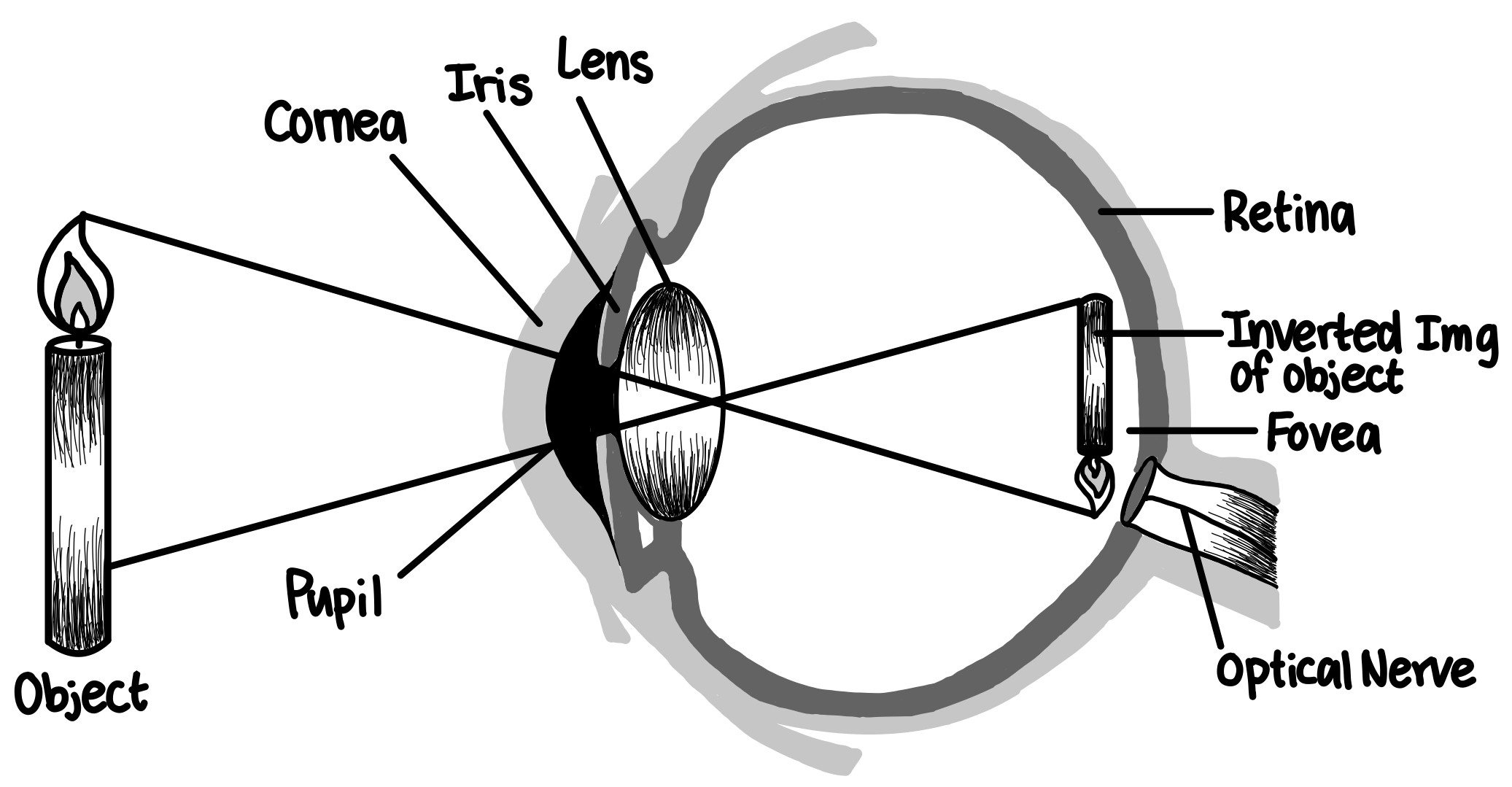
Blind spot
The spot where the optic nerve leaves the retina and has no rods or cones
Impulses from each side of the retina go to the corresponding hemisphere of the brain (left → left, right → right)
Optic Chiasm
Spot where the nerves cross each other
The visual cortex of the brain receives the impulses from the cells of the retina, and the impulses activate feature detectors.
Perception researchers David Hubel and Torsten Wiesel discovered that groups of neurons in the visual cortex respond to different types of visual images.
Feature detectors for vertical lines, curves, motion, etc.
Theories of Colour Vision
Trichromatic Theory
3 types of cones in the retina: cones that detect blue, red, and green
Cones are activated in different combinations to produce all the colours of the visible spectrum
Cannot explain some visual phenomena
Opponent-Process Theory
Sensory receptors arranged in the retina come in pairs
Red/Green, Yellow/Blue, Black/White
If one sensor is stimulated, its pair is inhibited from firing
Can explain visual phenomena
Afterimages
If you stare at one colour for a while and then look at a white or blank space, you will see a colour afterimage.
If you stare at green, the afterimage is red. If you stare at blue, the afterimage is yellow.
Colourblindness
Dichromatic: cannot see either red/green or blue/yellow shades.
Monochromatic: can only see shades of grey
Hearing
Amplitude
The height of the wave and determines the loudness of the sound (decibels)
Frequency
Length of the waves and determines the pitch (megahertz)
High-pitched sounds have high frequencies, and the waves are densely packed together.
Low-pitched sounds have low frequencies, and the waves are spaced apart.
Sound waves are collected in your outer ear (pinna) and travel down the ear canal until they reach the eardrum (tympanic membrane).
The membrane vibrates as the sound waves hit it and is attached to the first in a series of 3 small bones (collectively known as the ossicles)
Eardrum connects with the hammer (malleus), which connects to the anvil (incus), which connects to the stirrup (stapes)
The vibration of the eardrum is transmitted by these 3 bones to the oval window which is attached the to cochlea, a structure shaped like a snail’s shell filled with fluid. As the oval window vibrates, the fluid moves.
The floor of the cochlea is called the basilar membrane. It’s lined with hair cells connected to the organ of Corti, which are neurons activated by the movement of the hair cells. When the fluid moves, the hair cells move and transduction occurs. The organ of Corti fires, and these impulses are transmitted to the brain via the auditory nerve.
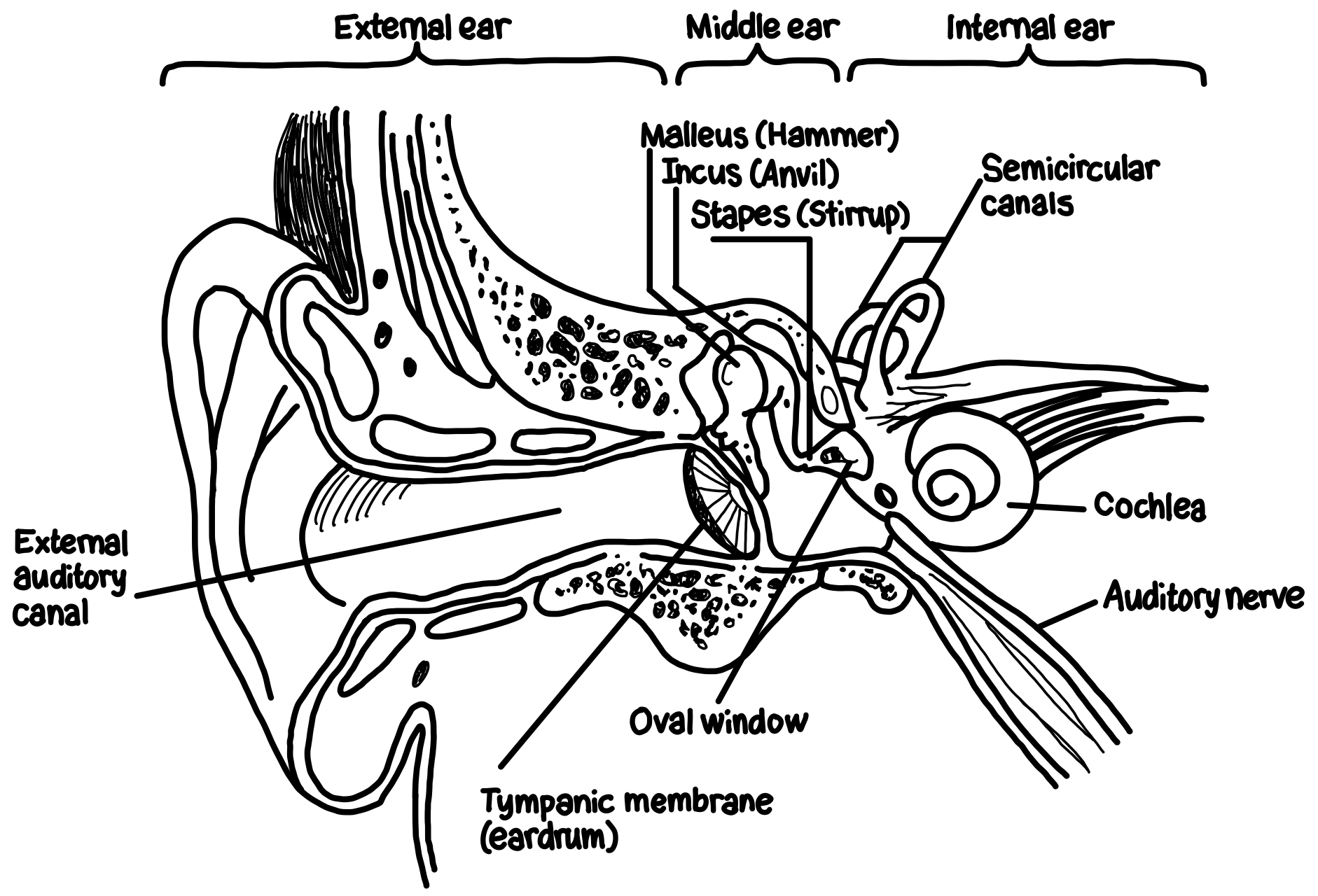
Pitch Theories
Place Theory
Hair cells in the cochlea respond to different frequencies of sound based on where they are located in the cochlea.
Some bend in response to high pitches and some to low.
We sense pitch because the hair cells move in different places in the cochlea
Frequency Theory
Place theory accurately describes how hair cells sense the upper range of pitches, but not the lower tones.
Lower tones are sensed by the rate at which the cells fire.
We sense pitch because the hair cells fire at different rates (frequencies) in the cochlea.
Deafness
Conduction Deafness
Occurs when something goes wrong with the system of conducting the sound to the cochlea (in the ear canal, eardrum, hammer/anvil/stirrup, or oval window).
Nerve (sensorineural) Deafness
Occurs when the hair cells in the cochlea are damaged, usually by loud noise.
Prolonged exposure to loud noise can permanently damage the hair cells in your cochlea, and these hair cells do not regenerate.
Touch
Gate-Control Theory
Some pain messages have a higher priority than others.
When a higher priority message is sent, the gate swings open for it and swings shut for a low priority message, which we will not feel.
Endorphins (pain-killing chemicals) also swing the gate shut
Chemical Senses
Taste (Gustation)
Chemicals from the food we eat are absorbed by taste buds on your tongue.
Taste buds are located on papillae, which are the bumps you can see on your tongue.
Humans sense 5 different types of tastes: sweet, salty, sour, bitter, and umami (savoury or meaty taste)
Some taste buds respond more intensely to a specific taste and more weakly to others.
People differ in their ability to taste food → the more densely packed the taste buds, the more chemicals are absorbed, and the more intensely the food is tasted
What was think of as the flavour of food is actually a combination of taste and smell
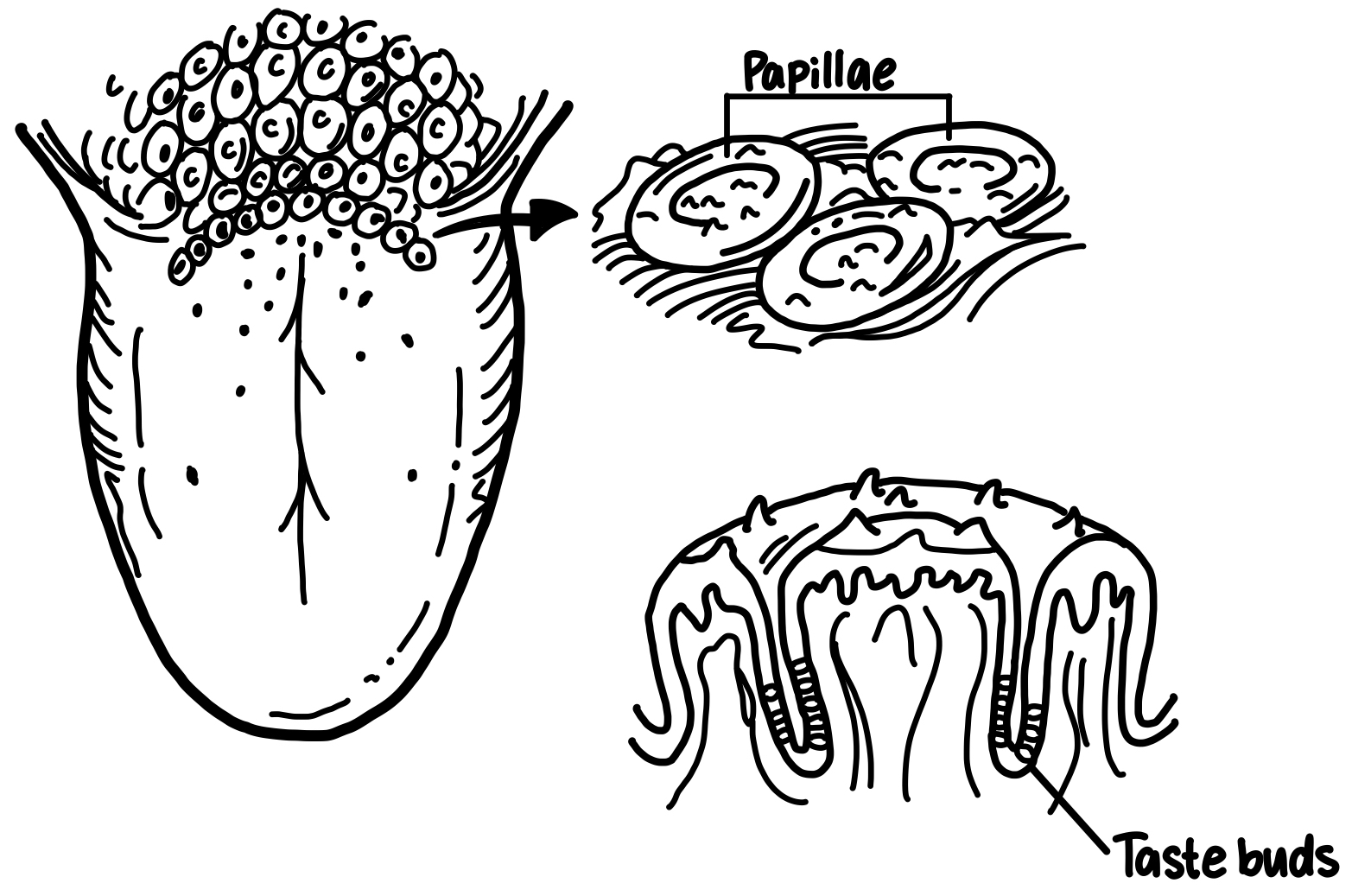
Smell (Olfaction)
Molecules settle in a mucous membrane at the top of each nostril and are absorbed by receptor cells located there.
Receptor cells are linked to the olfactory bulb, which gathers the messages from the olfactory receptor cells and sends this info to the brain.
Impulses from other senses, except smell, go through the thalamus first before being sent to the cortex, but info from our sense of smell go directly to the amygdala (emotional impulses) and then to the hippocampus (memory).
This direct connection to the limbic system may explain why smell is such a powerful trigger for memories.
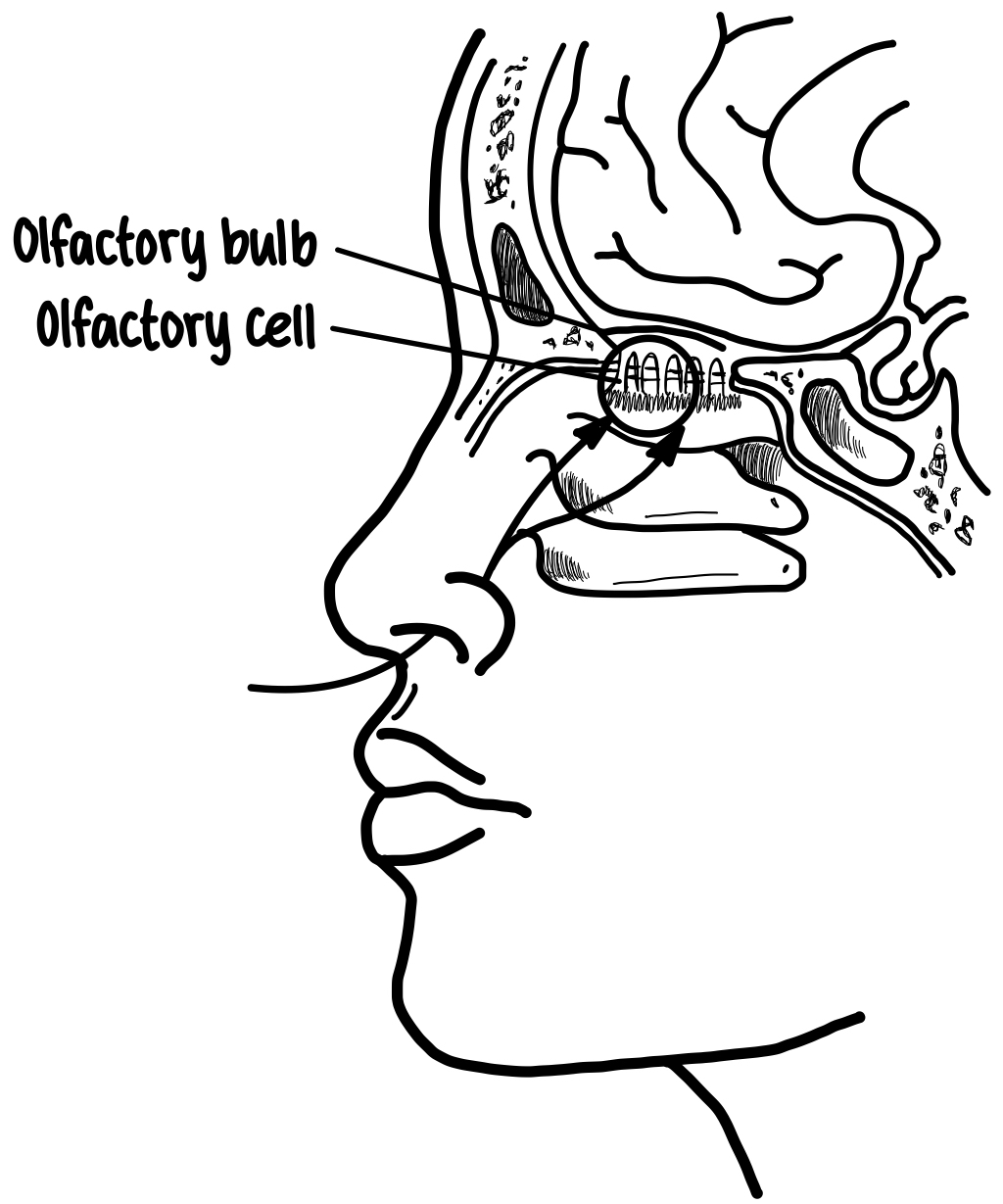
Body Position Senses
Vestibular Sense
Tells us about how our body is oriented in space.
3 semicircular canals filled with fluid in the inner ear give the brain feedback about body orientation
When position of your head changes, the fluid moves in the canals, causing sensors in the canals to move.
The movement of these hair cells activate neurons and their impulses go to the brain.
Kinaesthetic Sense
Tells us about the position and orientation of specific body parts.
Receptors in our muscles and joins send info to our brain about our limbs.
This info, along with visual feedback, lets us keep track of our body.
Perception
Thresholds
Absolute Threshold
The smallest amount of stimulus we can detect
Subliminal
Used to describe stimuli below our absolute threshold
The difference threshold (aka just-noticeable difference) is the smallest amount of change needed in a stimulus before we detect a change.
This threshold is computed by Weber’s law (or Weber-Fechner law).
States that the change needed is proportional to the original intensity of the stimulus. The more intense the stimulus, the more it will need to change before we notice a difference.
Each sense varies according to a constant, but the constants differ between the senses.
Constant for hearing is 5%, constant for vision is 8%
Perceptual Theories
Signal Detection Theory
Investigates the effects of the distractions and interference we experience while perceiving the world.
Tries to predict what we will perceive among competing stimuli
Takes into account how motivated we are to detect certain stimuli and what we expect to perceive
All the above factors are called the response criteria
False Positive
When we think we perceive a stimulus that is not there.
False Negative
When we don’t perceive a stimulus that is present.
Top-Down Processing
We perceive by filling in gaps in what we sense.
Occurs when you use your background knowledge to fill in gaps in what you perceive
Schemata
Mental representations of how we expect the world to be based on our experience
Perceptual Set
Predisposition to perceiving something in a certain way
Backmasking - supposed hidden messages musicians recorded backward in their music
Parent groups were concerned about backmasking, although it was not true. They thought there were threatening messages because they had schemata of this music as dangerous or evil.
Bottom-Up Processing
We use only the features of the object itself to build a complete perception.
Feature detectors in the visual cortex allow us to perceive basic features, such as lines, curves, motions, etc
Our mind builds the picture from the bottom up using these basic characteristics
Figure-ground relationship
What part of a visual image is the figure and what part is the ground or background?
Gestalt Rules
We normally perceive images as groups, not as isolated elements.

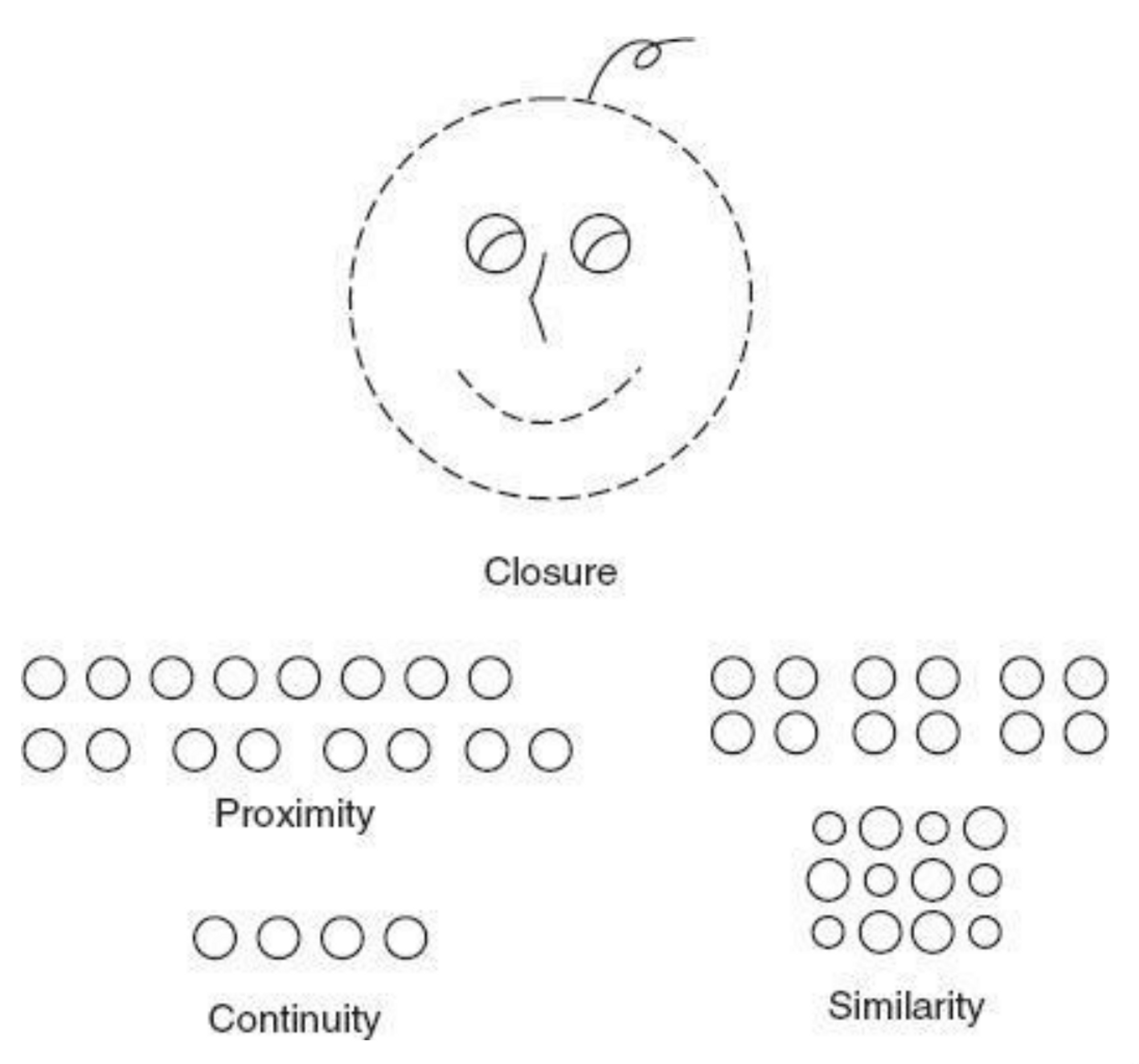
Constancy
Our ability to maintain a constant perception of an object despite changes in angle of vision, variations in light, etc.

Perceived Motion
Our brains perceive objects to be moving when, in fact, they are not.
Stroboscopic effect
Images in a series of still pictures presented at a certain speed will appear to be moving.
Examples: movies, flip books
Phi phenomenon
A series of lightbulbs turned on and off at a particular rate will appear to be one moving light.
Examples: movie marquees, holiday lights
Autokinetic effect
If a spot of light is projected steadily onto the same place on a wall of an otherwise dark room and people are asked to stare at it, they will report seeing it move.
Depth Cues
Eleanor Gibson
Used the visual cliff experiment to determine when human infants can perceive depth.
Infant is placed onto one side of a glass-topped table that creates the impression of a cliff.
Found that an infant old enough to crawl will not crawl across the visual cliff, implying the child has depth perception.
Cues we use to perceive depth:
Monocular cues - depth cues that do not depend on having two eyes
Binocular cues - cues that depend on having two eyes
Monocular Cues
Artists tend to use these to imply depth in their drawings.
Linear perspective
A railway track converging at the top of your paper to imply the tracks run away from the viewer off into the distance.
Relative size cue
Drawing the train larger when it’s closer to the viewer and smaller when it’s further
Interposition cue
Objects that block the view to other objects must be closer to us.
Texture gradient
Seeing more details in texture close to us but not far away.
Shadowing
Imply where the light source is and thus imply depth and position of objects
Binocular Cues
Binocular (retinal) disparity
Since each of our eyes sees any object from a slightly different angle, the closer the object is, the more disparity there will be between the images coming from each eye
Convergence
As an object gets closer to our face, our eyes must move toward each other to keep focused on the object.
The more the eyes converge, the closer the object must be.
Effects of Culture on Perception
The Muller-Lyer illusion:

Line A should look longer, though both lines are actually the same length. People who come from non-carpentered cultures that do not use right angles/corners in their buildings/architecture are usually not fooled by the Muller-Lyer illusion.
 Knowt
Knowt
